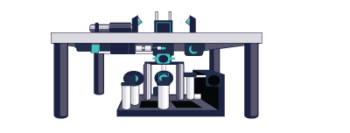Find out why Mid-IR is so Important.
Written by our Biophotonics Team Leader PeterCollins.
Mid-IR radiation is typically defined as 2.5 – 25 microns (though definitions change) and can be used to detect, identify and image molecules, enabling and advancing a wide range of applications.
What is contained within this article is information on the following:
- Applications – Gas Spectroscopy (TDLAS); Environmental Monitoring; Biomedical; Nanoscale Imaging
- Optical Sources – Inter-band Cascade Lasers; Quantum Cascade Lasers
- Mid-IR Optics
- Mid-IR Test & Measurement equipment
- List of links to >200 scientific papers and helpful tools
Background
Molecules are made up of two or more atoms that are chemically bonded together, they can exist in many different excited states, as the atoms can engage in a range of motions including bending, stretching, scissoring, twisting and rocking in addition to rotational motion around the bonds of the molecule.
All these energy states can be used to identify various materials, by the presence/absence of specific functional groups. To probe these energy states, IR light can be used in Vibrational spectroscopy, such as Near-IR, Raman and Mid-IR. The latter offers stronger spectral signatures with more identifying features, due to the interaction with the fundamental vibration bands.
Typical IR absorption for covalent bonds is 600 – 4000 cm-1. (It is common practice in spectroscopy to express transition frequencies in inverse centimetres or wavenumbers. Multiplying this quantity by the speed of light (c) gives the frequency in hertz; thus 1cm-1 is roughly 30GHz)
The graph below shows the regions of the spectrum where the following types of bonds normally absorb. For example, a sharp band around 2200-2400cm-1 would indicate the possible presence of a C-N or C-C triple bond.

One common area of the spectrum is referred to as the ‘Fingerprint Region’ or ‘Spectral Fingerprint’ and ranges from ~500 to 1500 cm-1. This is normally a complex area showing many bands, frequently overlapping each other.
As the molecules differ from each other by having different combinations of functional groups, their mid-IR spectra can be used to identify them and characterise their structure. As Mid-IR spectra of mixtures is additive, Individual components absorption bands can be isolated and used to quantify these individual components by their absorption strength.
1. Applications
Gas Spectroscopy
Tunable Diode Laser Spectroscopy (TDLAS), working principles can be found here is a very strong tool for highly selective and sensitive detection of ppm or ppb levels in concentrations. It allows for in situ, contactless measurements which are highly selective with a low cost of ownership. Common Gasses:

Commonly used in the Oil & Gas Industry for things like quality control in natural gas pipelines & Ethylene production, it is also used for leak control of hazardous gases and in process optimisation.
Environmental Monitoring
Environmental policies have been implemented worldwide to reduce greenhouse gas emissions. According to the United States Environmental Protection Agency, human activities account for more than three quarters of CO2 emissions. They are mainly due to the combustion of fossil fuels for energy generation, transportation and industry.
TDLAS is used tackling climate change for by remote sensing technologies in order to measure pollutants and greenhouses gasses, such as CO2, CO but also emissions related to Ethane C2H6 and Methane CH4. Methane is one of the Earth’s most important atmospheric gases. It is, to a large extend, responsible for the accelerating greenhouse effect. The global warming potential of methane is about 30 times higher than that of CO2 based on a 100-year scale. Also, emission of flue gasses such as NOx and SO2, which react to cause acid rain are restricted and need to be monitored.
Other applications are for health and safety in the workplace, by exposure monitoring. One such gas Formaldehyde has been used in consumer and industrial products since the beginning of the 19th century. Currently, the annual formaldehyde production accounts for 21 million tons. About 50% are processed as adhesives in pressed wood panels. In 2004 formaldehyde has been classified carcinogenic by the International Agency for Research on Cancer. Since then formaldehyde concentrations have been strictly controlled in the production process as well as in the finished product.
Biomedical
With many applications in Biomedical, a few highlighted below:
Protein Analysis: The ability to determine the secondary structure content of α-helix and β-sheet by changes in the Amide I band
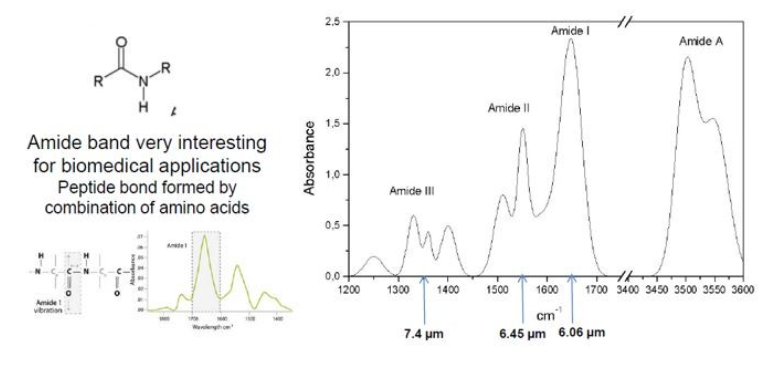
Liquid Chromatography/Bioreactor monitoring: Mid-IR Liquid Chromatography is now achievable with the Chemdetect with transmission measurement mode allowing long path lengths (>100 microns) for both aqueous and solvent-based solutions.
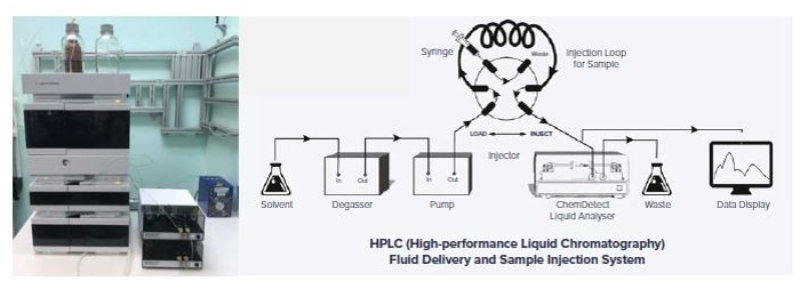
The ChemDetect is a compact, intelligent, and easy-to-use infrared spectrometer specifically designed for the detection of low-concentration (ppm) analytes in standard HPLC liquid columns.
Label-Free Digital Pathology:

Until recently, chemical staining or labelling, by using IHC stains or fluorescent tags was the only viable option for a researcher or pathologist to visualize diagnostic markers present within the tissue sections. Furthermore, using labels limits the potential for discovering new biomarkers within the sample. Learn how QCLs are being used for automated cancer classification by watching our supplier DRS Daylight Solutions webinar by Professor Kluass Gerwent of the Protein Diagnostic Centre at Ruhr University.
Nanoscale Imaging
Action- or force-based infrared microscopy is a family of infrared microscopy techniques that allow nanoscale infrared imaging and spectroscopy below the diffraction limit. The technique of photothermal induced resonance (PTIR) or photothermal expansion collects the infrared absorption responses through the detection of laser-induced contact resonance or volume expansion in the sample, respectively. They are collectively known as the AFM-IR technique. Wiki Link.
The combination of scanning probe microscopy with infrared illumination provides ways to beat the diffraction limit at mid-infrared frequencies. One of these techniques, infrared scattering-type scanning near-field optical microscopy (s-SNOM), uses a sharp metal-coated probe position-controlled by an atomic force microscope (AFM) to locally enhance the optical field and to excite the vibrational phonon or polaritonic resonances in the sample. Subsequently, the high–spatial frequency optical near field generated or attenuated by the presence of the sample is probed locally by the sharp probe, thus providing spatial contrast better than the diffraction limit of the propagating optical field.

Nanoscale imaging is a technique called – Peak force infrared (PFIR) microscopy. PFIR allows chemical imaging, collection of broadband infrared spectra, and mechanical mapping at a spatial resolution of 10nm.
Credit: Nanoscale simultaneous chemical and mechanics imaging via peak force infrared microscopy.
2. Optical Sources
Laser 2000 UK work with Nanoplus GmbH for components mainly used in industrial segments such as process monitoring and gas sensing and DRS Daylight Solutions for systems, mainly used in research.
A key product of Nanoplus are complex coupled distributed feedback laser diodes. Nanoplus provides these mono-mode semiconductor lasers at any wavelength between 760nm and 14000nm. Details of the DFB laser concept can be found here.
Nanoplus have a unique DFB concept in the Mid-IR based around Interband Cascade Lasers (ICLs) which span from 3000nm – 6000nm and Quantum Cascade Lasers (QCLs) which span from 6000nm – 14000nm.
Intra-band and Quantum Cascade Lasers are now industrialised grade, room temperature products and being used in the most demanding applications. Details can be found here, powers ranging from 1 – 9mW depending on wavelength.

These line-narrow lasers are wavelength tuned by both temperature and current allowing for very specific absorptions features to be analysed.
Typically end users are building their own gas sensing equipment and use their own diode drivers and mounts, but if you are in the early stages of development or in research we have a range of laser diode mounts and drivers which we would be happy to advise.
DRS Daylight Solutions provide Laser systems, Liquid Chromatography Analysers and Hyperspectral imaging microscopes all based around their core technology of providing monochromatic feedback by constructing an external cavity (ECqcL). The free-running linewidth of the emission can be reduced to as little as 0.00002 cm-1 (~0.5MHz).
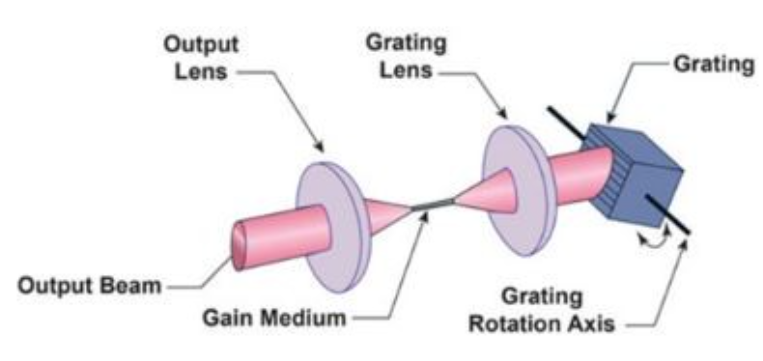
DRS Daylight Solutions patented design uses a double-ended Littrow configuration, which provides mode hop free tuning. With this design, it is possible to demonstrate >120 cm-1 of mode hop-free tuning and over 500 cm-1 of overall tuning. Typical tuning curves below
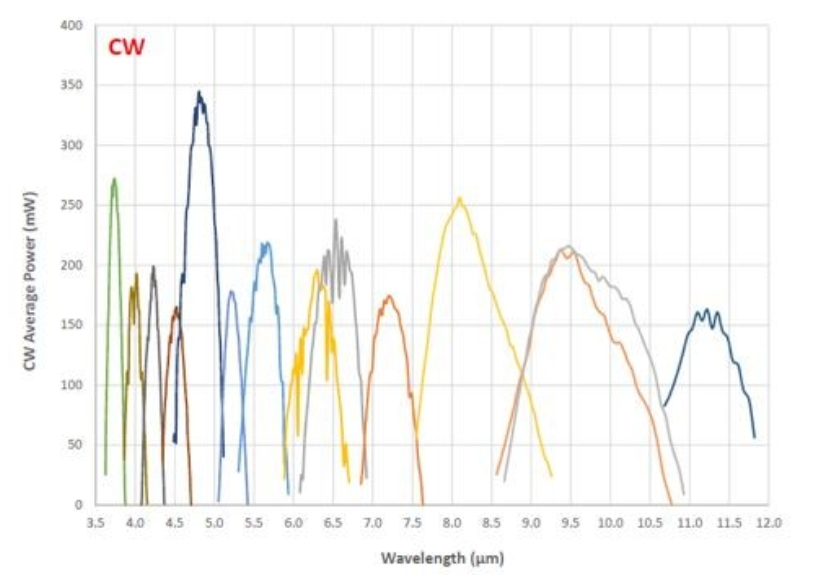
Whether you need CW output, pulsed output, fast tuning, broad tuning, linewidths <5 MHz, Watt-level output powers, or low RIN, please ask how our unmatched selection of mid-IR lasers, spanning 3 to >13 μm, can help you. The main product groupings for Lasers are:
- MIRcat Mid-IR Laser (Rapid-Scan Ultra-Broadly Tunable, > 950cm-1)
- Hedgehog™ Compact, Rapid-Scan Mid-IR Lasers (Broadly Tunable)
- CW-MHF™ Mid-IR Lasers (Narrow Linewidth)
- Aries™ / Unicorn™ Mid-IR Lasers (High Power, Fixed Wavelength)
3. Mid-IR Optics
Laser 2000 UK work with Innovation Photonics who provide unique products for the Mid-IR.
- Mid-IR ISOLATORS
- IR POLARISERS
- IR POLARISATION ROTATOR
- FLAT-TOP BEAM EXPANDER
- FIBRE-OPTIC COUPLING LENSES
- MID-IR FOCUSING OBJECTIVES
- FIBRE-OPTIC COLLIMATORS
- MID-IR FIBRE COLLIMATORS
- IR FIBRE CABLES
Details can be found in the catalogue which can be found here.
4. Mid-IR Test & Measurement Equipment
If you are working in the Mid-IR using Intra-band and Quantum Cascade Lasers, it is a relatively expensive waveband to operate in, so you need to make sure your Lasers produce high quality light that give high signal to noise.
High quality can refer to beam and spectral quality, such as linewidth, power, pointing, spectral repeatability and beam shape.
In order to test these specifications Laser 2000 offers:
- IR Laser Spectrum Analysers and Wavelength Meters
- IR Beam Profilers
- Amplified MCT Detectors
- Optical Power and Energy Meters
One unique product is the 771 Series Laser Spectrum Analyser, which provides the most complete wavelength and spectral characterisation of CW and high-repetition rate pulsed lasers that operate from 375nm to 12 µm.
These systems combine proven Michelson Interferometer-based technology with fast Fourier transform analysis for accurate measurement of absolute wavelength to ± 0.0001nm and high resolution spectral analysis to 2 GHz. As with all products from Bristol Instruments, every measurement is guaranteed by continuous calibration with a built-in wavelength standard.
Contact us here:
5. List of links to >200 scientific papers and helpful tools
Scientific Papers:
Daylight Solutions – https://www.daylightsolutions.com/resources/scientific-research-papers/
Nanoplus – https://nanoplus.com/en/library/literature/











